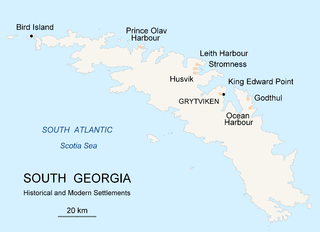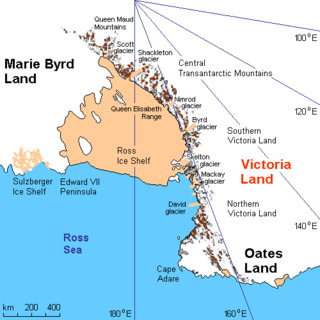
Joinville Island is the largest island of the Joinville Island group, about 40 nautical miles long in an east–west direction and 12 nautical miles wide, lying off the northeastern tip of the Antarctic Peninsula, from which it is separated by the Antarctic Sound.
Northeast Glacier is a steep, heavily crevassed glacier, 13 nautical miles long and 5 nautical miles wide at its mouth, which flows from McLeod Hill westward and then south-westwards into Marguerite Bay between the Debenham Islands and Roman Four Promontory, on the west coast of Graham Land, Antarctica.

Jason was a Norwegian whaling vessel laid down in 1881 by Rødsverven in Sandefjord, Norway, the same shipyard which later built Ernest Shackleton's ship Endurance. The ship, financed by Christen Christensen, an entrepreneur from Sandefjord, was noted for his participation in an 1892–1893 Antarctic expedition led by Carl Anton Larsen.
McNish Island is the larger of two islands lying at the east side of Cheapman Bay on the south side of South Georgia. It was surveyed by the South Georgia Survey in the period 1951–57, and named by the United Kingdom Antarctic Place-Names Committee (UK-APC) for Harry McNish (1858-1930), carpenter on Sir Ernest Shackleton's Imperial Trans-Antarctic Expedition of 1914–1917. The name was changed from McNeish Island to McNish Island in 1998 after submittal of Henry McNish's birth certificate to the United Kingdom Antarctic Place-Names Committee proved the correct spelling of his surname.

Prince Olav Harbour is a small harbour in the south west portion of Cook Bay, entered between Point Abrahamsen and Sheep Point, along the north coast of South Georgia.
Esmark Glacier is a glacier flowing into the west part of Jossac Bight on the south coast of South Georgia. It was named by the Norwegian expedition under Olaf Holtedahl, 1927–28, most likely for Jens Esmark, professor of mineralogy at the University of Kristiania (Oslo), Norway. To the northwest is Mount Cunningham.

Salisbury Plain is a broad coastal plain found with the Bay of Isles on the north coast of South Georgia. It lies between the mouths of Grace and Lucas glaciers on the southern coast of the bay, with Mount Ashley south of it. Best known as the breeding site for as many as 60,000 King penguins, its beaches are also covered with many Southern elephant seals and Antarctic fur seals.
The Samuel Islands are a group of small islands and rocks lying close to the south coast of South Georgia, 1.6 km west-southwest of Nilse Hullet and 3.2 km east-southeast of Klutschak Point. Surveyed by the SGS in the period 1951–57. Named by the United Kingdom Antarctic Place-Names Committee (UK-APC) after the catcher Don Samuel, built in 1925 and later owned by the Compania Argentina de Pesca, Grytviken, which sank in the vicinity of these islands in 1951.
Crean Glacier is a glacier 4 miles (6.4 km) long, flowing northwest from Wilckens Peaks to the head of Antarctic Bay on the north coast of South Georgia. It was surveyed by the South Georgia Survey in the period 1951–57 and named by the UK Antarctic Place-Names Committee for Irishman Tom Crean, Second Officer of the Endurance during the British expedition under Ernest Shackleton, 1914–16. Crean accompanied Shackleton and Frank Worsley in the James Caird from Elephant Island to King Haakon Bay, South Georgia, and made the overland crossing with them to Stromness; this glacier lies on the route.
Mount Globus is a mountain, 1,270 metres (4,170 ft) high, between Fanning Ridge and Mount Corneliussen at the west end of the Allardyce Range of South Georgia. It was surveyed by the South Georgia Survey in the period 1951–57, and was named by the UK Antarctic Place-Names Committee for Hvalfangerselskapet Globus A/S, a Norwegian whaling company founded in 1924, which first used the plan patented by Petter Sorlle for processing whales in a factory ship fitted with a slipway.
Mount Skittle is a prominent rocky mountain, 480 m, forming the north limit of Saint Andrews Bay on the north coast of South Georgia. The name "Kegel-Berg" was given for this feature by the German group of the International Polar Year Investigations, 1882–83. During the SGS, 1951–52, the mountain was identified and located. An English form of the name, Mount Skittle, was recommended by the United Kingdom Antarctic Place-Names Committee (UK-APC) in 1954.
Briggs Glacier is a glacier between Mount Worsley and The Trident in central South Georgia, flowing northwest into Murray Snowfield. It was charted as a glacier flowing into the head of Possession Bay in 1929 by Lieutenant Commander John M. Chaplin, Royal Navy (1888–1977). Chaplin was survey officer aboard RRS Discovery during the Discovery Oceanographic Expedition of 1925–1927, and was later in charge of a hydrographic survey party in South Georgia, 1928–30.

The Scott Glacier is a major glacier, 120 nautical miles long, that drains the East Antarctic Ice Sheet through the Queen Maud Mountains to the Ross Ice Shelf. The Scott Glacier is one of a series of major glaciers flowing across the Transantarctic Mountains, with the Amundsen Glacier to the west and the Leverett and Reedy glaciers to the east.
Helland Glacier is a glacier 4 nautical miles (7 km) long flowing southwest from Mount Paget to Rocky Bay, on the south side of South Georgia. It was mapped by Olaf Holtedahl during his visit to South Georgia in 1927–28, and named by him for Amund Helland, a Norwegian mining geologist and glaciologist.
Jewell Glacier is a short glacier flowing south-southwest from Mount Grant into Jossac Bight on the south coast of South Georgia. It was named by the UK Antarctic Place-Names Committee in 1982 after John A. Jewell, a British Antarctic Survey field assistant in this area in 1976–77, at Rothera Research Station in 1977–78, and Base Commander at Rothera, 1978–80.
Brutus Island is a small island lying near the center of Prince Olav Harbour on the north coast of South Georgia. The descriptive name Saddle Island was given for this feature, probably by a British expedition under Ernest Shackleton, 1921–22, but the same name is used elsewhere in the Antarctic; to avoid confusion a new name has been approved for this feature. The name Brutus Island, after the hulk Brutus, which was towed across with coal from South Africa by two small catchers and has for many years been moored alongside the whaling station in Prince Olav Harbour, was proposed by Harold Salvesen.
McIlroy Peak is a peak rising to 745 metres (2,440 ft) west of Husvik Harbour and 0.8 nautical miles (1.5 km) south of Mount Barren, South Georgia. It was named by the UK Antarctic Place-Names Committee in 1990 after Dr. James A. McIlroy, surgeon on the British Imperial Trans-Antarctic Expedition, 1914–16, in the Endurance, and on the Shackleton–Rowett Expedition, 1921–22, in the Quest.

The Hull Glacier is a glacier, about 35 nautical miles long, flowing northwest between Mount Giles and Mount Gray into Hull Bay, in Marie Byrd Land, Antarctica.
Luisa Bay is a small bay lying between Cape Vakop and Mount Skittle on the north coast of South Georgia. It was surveyed by the South Georgia Survey, 1951–52, and named by the UK Antarctic Place-Names Committee for the Luisa, one of the vessels of the Compañía Argentina de Pesca which participated in establishing the first permanent whaling station at Grytviken, South Georgia, in 1904. The vessel is now a hulk lying in King Edward Cove.
Vincent Islands is a small group of islands at the head of King Haakon Bay on the south side of South Georgia. Roughly charted by the British expedition under Shackleton, 1914–16, and surveyed by the SGS in the period 1951–57. Named by the United Kingdom Antarctic Place-Names Committee (UK-APC) for J. Vincent, boatswain of the Endurance, 1914–16, who accompanied Shackleton in the James Caird from Elephant Island to King Haakon Bay.
![]() This article incorporates public domain material from "Mount Worsley". Geographic Names Information System . United States Geological Survey.
This article incorporates public domain material from "Mount Worsley". Geographic Names Information System . United States Geological Survey. 




